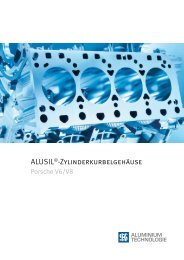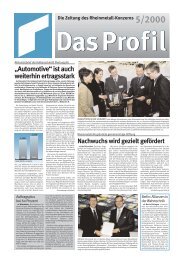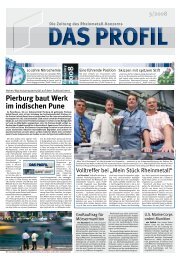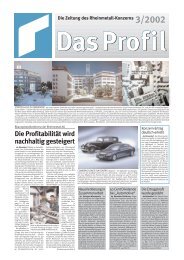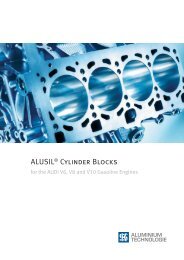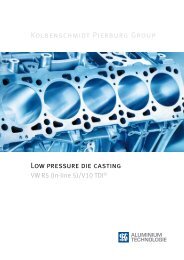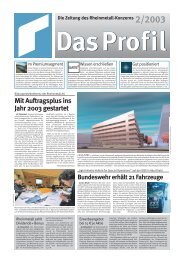High-pressure Die Cast Cylinder Blocks Made of ... - KSPG AG
High-pressure Die Cast Cylinder Blocks Made of ... - KSPG AG
High-pressure Die Cast Cylinder Blocks Made of ... - KSPG AG
You also want an ePaper? Increase the reach of your titles
YUMPU automatically turns print PDFs into web optimized ePapers that Google loves.
1. Aluminium cylinder blocks support light weight<br />
design<br />
<strong>Cast</strong>ings <strong>of</strong> aluminium are making an evermore significant<br />
contribution to leveraging light construction potentials in<br />
modern passenger cars. The heaviest individual component,<br />
the cylinder block, has meanwhile taken on a key role. If we<br />
consider the enormous number <strong>of</strong> in-line engines produced,<br />
especially four-cylinder and three-cylinder engines, but increasingly<br />
also six-cylinder engines in in-line and V arrangement,<br />
the cost/benefit aspect must have absolute priority.<br />
The replacement <strong>of</strong> grey cast iron with aluminium for cylinder<br />
blocks therefore presupposes low-cost concepts.<br />
2. Concept diversity for aluminium cylinder blocks<br />
Contrary to the cylinder blocks produced so far, mostly made<br />
from grey cast iron based on a uniform concept which already<br />
incorporates the cylinder bore surfaces when a perlitic<br />
structure configuration is chosen, there are many diverse<br />
options in the case <strong>of</strong> aluminium. These relate to the concept<br />
modules <strong>of</strong> type or cylinder block design, alloy, casting<br />
method and cylinder bore surface, in which case manifold<br />
incompatibilities have to be considered. The overriding aspect<br />
is therefore the compatibility <strong>of</strong> the concept modules.<br />
2<br />
Fig. 1: <strong>High</strong>ly efficient solution specifically for passenger car in-line engines<br />
A further constraint for the concepts which are viable in principle<br />
results for concrete engine development projects from<br />
the targets and general specifications with respect to the engine<br />
function, elemental engine characteristics (number and<br />
arrangement <strong>of</strong> cylinders), annual outputs, costs <strong>of</strong> castings<br />
and engine systems, optimization potential, environmental<br />
aspects and recyclability. This situation has led to a large<br />
number <strong>of</strong> marketable concepts.<br />
3. Aluminium cylinder blocks and high-<strong>pressure</strong><br />
die casting method<br />
3.1 Economic aspect<br />
From the economic aspect, for mass produced engines, high<strong>pressure</strong><br />
die casting is mainly competing with the highly<br />
automated sand core package process whose cycle time is<br />
not bound to the solidification. In the highly competitive,<br />
cost-sensitive market segment <strong>of</strong> the three-cylinder and<br />
four-cylinder engines, however, high-<strong>pressure</strong> die casting is<br />
unrivalled in cost-effectiveness thanks to outstanding productivity<br />
based on appropriate component design. Currently,<br />
worldwide large quantities <strong>of</strong> four-cylinder engine blocks <strong>of</strong><br />
aluminium are made by this method. The aluminium high<strong>pressure</strong><br />
die casting method is now also in the process <strong>of</strong><br />
establishing itself in the six-cylinder engine business.



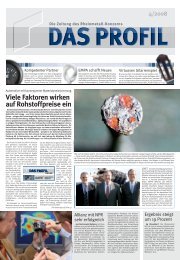
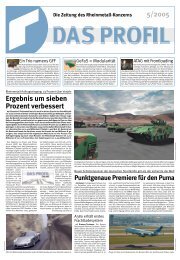
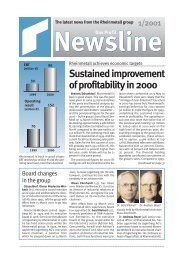

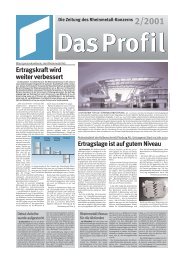
![PDF [1.0 MB] - KSPG AG](https://img.yumpu.com/5513074/1/171x260/pdf-10-mb-kspg-ag.jpg?quality=85)
